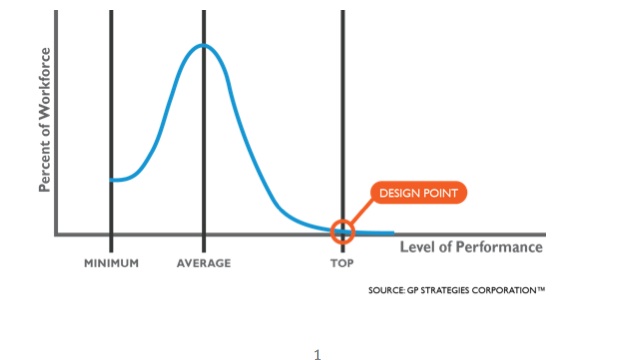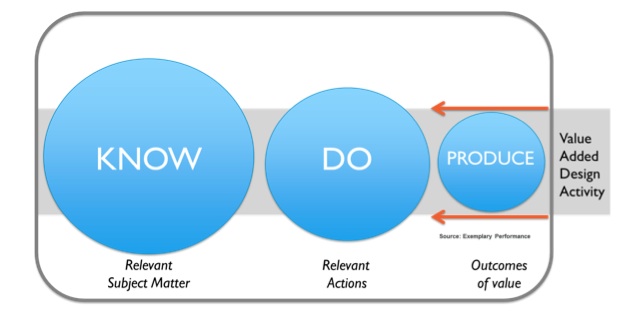
We have all endured “bad” courses or training events. Such events are painful for participants and waste valuable time. It is no wonder then that as an industry we are infatuated with new techniques and technologies aimed at improving the participants’ experience and maximizing engagement during training activities. In this relentless pursuit, however, we must guard against falling prey to the following false reasoning:
Engaging training is good training.
Good training provides business impact.
Therefore, engaging training provides business impact.
While at first blush this statement seems logical, we all know from personal experience that it is possible to be totally engaged during a learning event only to muse at the end, “What do I do differently now to improve my performance?”
Meaningful training must be both engaging and impactful. While surveying participants to measure the engagement created by a training design is relatively easy, how do we increase the probability that the method will cover areas that actually will have an impact on business performance? Our work over the last 25 years has focused on an effective and straightforward way of accomplishing this.
Step 1: Determine a business impact design point
As we consider improving people’s impact in any given role, we must recognize that a normal distribution of performance exists across the role. This distribution typically takes the following shape.

We can see that in this distribution a small number of individuals (top performers) outperform the rest by a significant margin and consequently contribute disproportionately to business impact. We have discovered over the years that these top performers think differently about the role. They have developed and applied a mental model to their work that differs (often substantially) from that of the average performers. Isolating this model and learning from the top performers is the key to establishing a credible design point for learning. By doing so, we ensure the training we develop is naturally targeted to key areas that will impact the business.
Step 2: Develop a model of business success
Although top performers hold an effective mental model of the work, they typically have become unconsciously competent. Their expertise must be teased out and described in a way that can be emulated by others: namely, the average performers in the middle of the distribution curve. To do this, our work with top performers focuses on understanding what they produce that is of value to the organization as opposed to what they do or what we believe they know. We call these tangible products outcomes. Typically, people who excel in their role focus on five to seven key outcomes. This focus on outcomes and the tasks to produce them enables top performers to create business impact that far exceeds that of their peers. Taken collectively, these context-rich outcomes describe a model of success for the top performers and the role.
Step 3: Target knowledge and skills to develop
The outcomes and the associated tasks necessary to produce them to standard describe a model of success or standard of excellence for any given role and, thus, form a natural filter to determine the relevant skills and knowledge applicable to that role. This filter focuses and streamlines the objectives of the learning program to be developed. The figure below illustrates how the outcomes can be used to work backward through the possible skills and knowledge to isolate those that are important to produce the desired outcomes.

In our experience, using an outcomes approach reduces the time that must be devoted to training by one-third to one-half. Additionally, this method:
- Reduces the amount of time individuals are away from their jobs
- Substantially slashes the cost of training
- Enables more focused instructional design to improve engagement
While these points are important, the chief benefits remain boosting the incumbents’ level of excellence and greatly reducing the time to competence of workers new to the role.
Step 4: Design and deliver training that matters
With the objectives of the training focused, clear, and streamlined, the need for effective and engaging training design takes center stage. Design activity now can turn its attention to such questions as these: Is there a mobile component to the training? What is the media strategy? Is gamification a suitable strategy for the audience? Is this program being implemented with a global audience? How large is the audience? What is the desired time line to fully deploy the program?
Each of these questions may present its own challenges, but the overall objective of the program is well defined and straightforward: develop and deploy a training program to equip the entire role population to produce the outcomes currently being produced only by the top performers.
Step 5: Follow up with outcomes-based coaching
The science is well documented. No single training event can deliver the individual or organizational behavior change that all training programs desire. A deliberate follow-up strategy to embed the learning is required to ensure application and adoption in the workplace. Most would agree there is no better and effective strategy than direct supervisor coaching.
Though we all have heard this before, successful coaching programs are rare. The difference made possible by the outcomes approach described here lies in the use of documented, clear outcomes by which to evaluate in-role performance. And because the outcomes are tangible, they are also measurable. For many, measurement comes with a negative connotation. This need not—and should not—be the case, however. Outcomes represent positive and value-added accomplishments of top performers. Outcomes-based coaching focuses on establishing a positive and meaningful conversation between performer and supervisor to mutually create individually tailored in-role development plans.
These are exciting and transformational times for the training industry. We have at our fingertips both the design approach required to pinpoint the outcomes that impact the business and the rich tool set necessary to deliver engaging programs. Combined, they make the task of properly equipping individuals to deliver business impact possible and gratifying.
Greg Long and Butler Newman provide consulting services worldwide to help organizations realize improved business results. They are both vice presidents of organizational excellence at GP Strategies Corporation and coauthors of “The New Game Changers: Driving Performance by Focusing on What Matters.”




